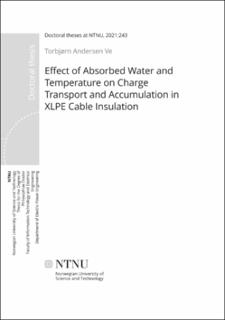| dc.description.abstract | As the use of HVDC subsea power cables increases, studying DC phenomena in wet conditions becomes increasingly important. Space charge accumulation and transport in the insulation is relevant for ageing and the ability to resist failure due to voltage transients.
This thesis investigates the effect of absorbed water on conducted current and space charge accumulation in cross-linked polyethylene (XLPE) insulation with semiconducting polymer electrodes. Two different measurement techniques were utilised: polarisation-depolarisation current measurement and the pulsed electroacoustic space charge measurement technique. Temperatures between 20–80 °C, which are within the temperature range found in a cable in service, were chosen. Measurements were conducted on samples with water contents of between 4 and 90% saturation levels.
Measurements of conducted current showed that the presence of absorbed water increases the apparent electrical conductivity in XLPE up to 3.5 times the dry-state conductivity, with an exponential temperature and electrical field dependency that does not significantly change from dry to wet insulation. Several commonly used conduction mechanisms were found to be able to describe the current in samples with the same water content, but no single conduction mechanism could predict the changes in conductivity with water content. A dual-mechanism model was tested and found to describe the changes in conductivity across all measured levels of applied electric, temperature and water content, albeit with parameters outside what is possible for the base physical mechanisms.
Measurements of space charge accumulation showed that injected charge was likely dominant in both dry and wet samples, with absorbed water increasing charge mobility at temperatures up to 60 °C. The increase in mobility was supported by measurements of time-dependent current. At temperatures above 20 °C, positive charge was the main contributor to space charge, both for wet and dry samples. At 80 °C, absorbed water seemed to differ in effect compared to the lower temperatures, leading to increased amounts of accumulated charge that did not stabilise within the measurement period.
In summary, the effect of absorbed water on conducted current and accumulated space charge does not appear to be critical for XLPE insulation systems at temperatures of 20–60 °C. At higher temperatures, further investigation is warranted, given the apparent detrimental change in mechanism for accumulated charge in wet conditions at 80 °C. | en_US |
